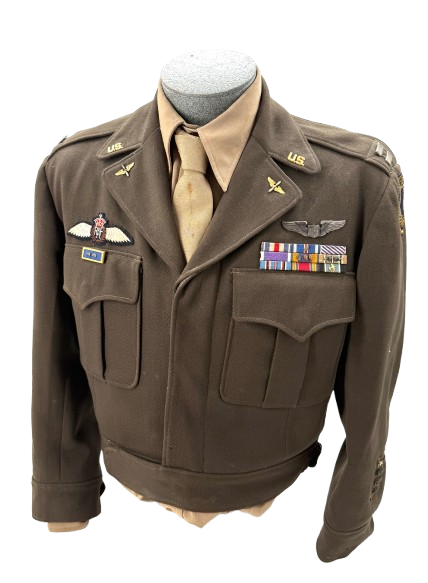American Eagles in British Skies: Eagle Squadrons in World War II
Uniform of Gilbert Hasley- After graduating from Cement High School and attending the University of Oklahoma for a year, he pursued aviation training at Spartan Air School. On May 1, 1941, he enlisted in the Royal Air Force, joining No. 121 (Eagle) Squadron, composed of American volunteer pilots. He took part in several missions, including the Dieppe Raid on August 19, 1942, where he was credited with 1 kill of a German Fw 190.
Following the U.S. entry into World War II, he transferred to the 335th Fighter Squadron, 4th Fighter Group, 8th Air Force on September 16, 1942. He rose quickly through the ranks, becoming Flight Commander, then Squadron Commanding Officer, and was promoted to Major in July 1943. He held several leadership and operational roles within the 4th Fighter Group, including Assistant Group Operations Officer.
On January 1, 1944, he assumed command of the 336th Fighter Squadron, where he participated in the first long-range USAF fighter penetration into Germany using belly tanks. On March 8, 1944, he was reassigned to the 468th Fighter Squadron, 508th Fighter Group in Oahu, Hawaii, where he served until 1945.
Before the United States officially entered World War II, a group of courageous young Americans took to the skies—not under the stars and stripes, but under the Union Jack. These were the men of the Eagle Squadrons, American volunteer pilots who joined Britain’s Royal Air Force (RAF) to fight Nazi Germany in the critical early years of the war.
In 1940, as Britain stood virtually alone against the growing might of Hitler’s Luftwaffe, many in the U.S. were still committed to isolationism. But a few Americans felt differently. Driven by a sense of justice, adventure, or a desire to stand up to tyranny, they found a way to join the RAF even before their own country was at war.
To facilitate this, British officials created special units known as the Eagle Squadrons. These were RAF squadrons made up almost entirely of American volunteer pilots. They would eventually number three:
No. 71 Squadron (formed September 1940)
No. 121 Squadron (formed May 1941)
No. 133 Squadron (formed August 1941)
Though many of the early volunteers lacked formal military flight training, they were often experienced civilian pilots, some even barnstormers or stunt fliers. The RAF quickly brought them up to military standards, training them to fly iconic British fighters such as the Supermarine Spitfire and the Hawker Hurricane.
Initially, the Eagle Squadrons participated in convoy protection, bomber escort missions, and patrols over the English Channel. As the war escalated, they took on increasingly dangerous offensive missions over occupied France and the Low Countries.
The Eagle Squadron pilots gained a reputation for aggressive flying and remarkable bravery. By mid-1942, they had collectively shot down over 70 enemy aircraft, although these victories came at a cost. Nearly a third of the original volunteers were killed, captured, or went missing in action.
Despite the risks, their efforts inspired both American and British publics. Newsreels and newspapers in the U.S. followed their exploits closely, helping shift American public opinion toward support for the Allied cause.
After the United States entered the war in December 1941, plans were made to integrate the Eagle Squadrons into the newly expanding U.S. Army Air Forces (USAAF). On September 29, 1942, the three Eagle Squadrons were officially transferred and became:
No. 71 Squadron → 334th Fighter Squadron
No. 121 Squadron → 335th Fighter Squadron
No. 133 Squadron → 336th Fighter Squadron
These squadrons were incorporated into the 4th Fighter Group, one of the most successful units in the European Theater.
The story of the Eagle Squadrons remains one of the most compelling examples of international volunteerism in modern warfare. These men didn’t wait for their country to act; they followed their consciences, risking everything for a cause they believed in.
Their legacy lives on in the 4th Fighter Wing of the modern U.S. Air Force, which traces its lineage back to these pioneering squadrons.


